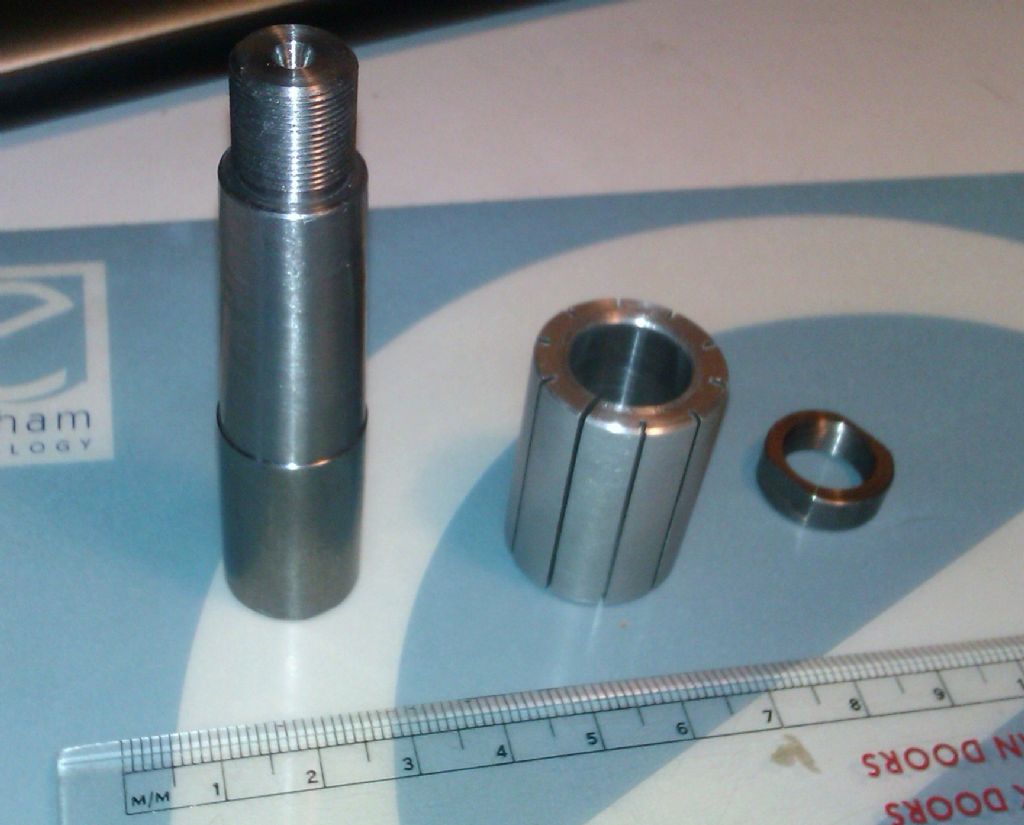Fluffy
Well-Known Member
G'Day All,
After honing the cast iron cylinder (Ø30mm) for my current engine with a brake cylinder hone I was not satisfied with the result. The cylinder finish up with a slightly reduced diameter at approx. the mid point of the cylinder length, just enough to stop the free movement of the piston through the bore. I used the brake cylinder hone as I did not have any other type of hone for this diameter.
Fortunately, I had ordered Issue No.16 of Model Engine Builder magazine for some other information. In the issue is an article by Dwight Giles & Mike Rehmus, on the construction of cylinder hones that use a No.2 morse taper to expand the lap sleeve. Hopefully problem solved!
I then made the components of the hone with a larger lap sleeve than the article, cutting the slots 1.5mm deeper to compensate for the larger diameter. The mandrel taper was turned by offsetting the tailstock & checking the taper with a No.2 drill taper sleeve & Prussian blue. The taper in the lap sleeve was produced by boring an undersize taper & finishing with a No. 2 reamer. All the slots in the lap sleeve have been cut with a 0.040" slitting saw. Result, fantastic.. The lap sleeve expanded easily & more importantly, parallel & solved the problem in about 20 minutes. I used 1200 grit diamond paste as the cutting medium.
If you need to make a cylinder lap I can recommend this type. Using smaller Morse tapers for smaller diameter laps should work. One lap sleeve is made from 6061 Aluminium & the other from Phosphor Bronze, both are 75mm in length. The adjusting thread in this case is Ø5/16" brass thread used for the fine pitch.
Regards,
Don.


After honing the cast iron cylinder (Ø30mm) for my current engine with a brake cylinder hone I was not satisfied with the result. The cylinder finish up with a slightly reduced diameter at approx. the mid point of the cylinder length, just enough to stop the free movement of the piston through the bore. I used the brake cylinder hone as I did not have any other type of hone for this diameter.
Fortunately, I had ordered Issue No.16 of Model Engine Builder magazine for some other information. In the issue is an article by Dwight Giles & Mike Rehmus, on the construction of cylinder hones that use a No.2 morse taper to expand the lap sleeve. Hopefully problem solved!
I then made the components of the hone with a larger lap sleeve than the article, cutting the slots 1.5mm deeper to compensate for the larger diameter. The mandrel taper was turned by offsetting the tailstock & checking the taper with a No.2 drill taper sleeve & Prussian blue. The taper in the lap sleeve was produced by boring an undersize taper & finishing with a No. 2 reamer. All the slots in the lap sleeve have been cut with a 0.040" slitting saw. Result, fantastic.. The lap sleeve expanded easily & more importantly, parallel & solved the problem in about 20 minutes. I used 1200 grit diamond paste as the cutting medium.
If you need to make a cylinder lap I can recommend this type. Using smaller Morse tapers for smaller diameter laps should work. One lap sleeve is made from 6061 Aluminium & the other from Phosphor Bronze, both are 75mm in length. The adjusting thread in this case is Ø5/16" brass thread used for the fine pitch.
Regards,
Don.

































































